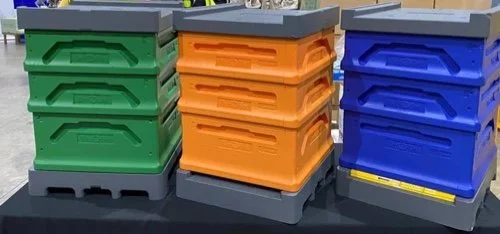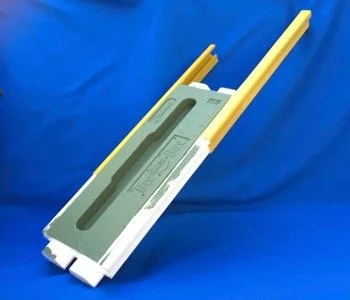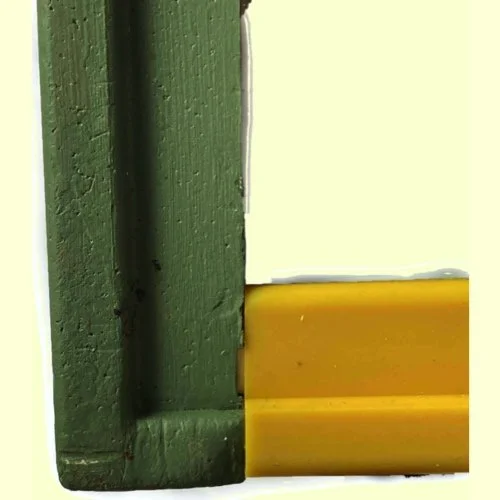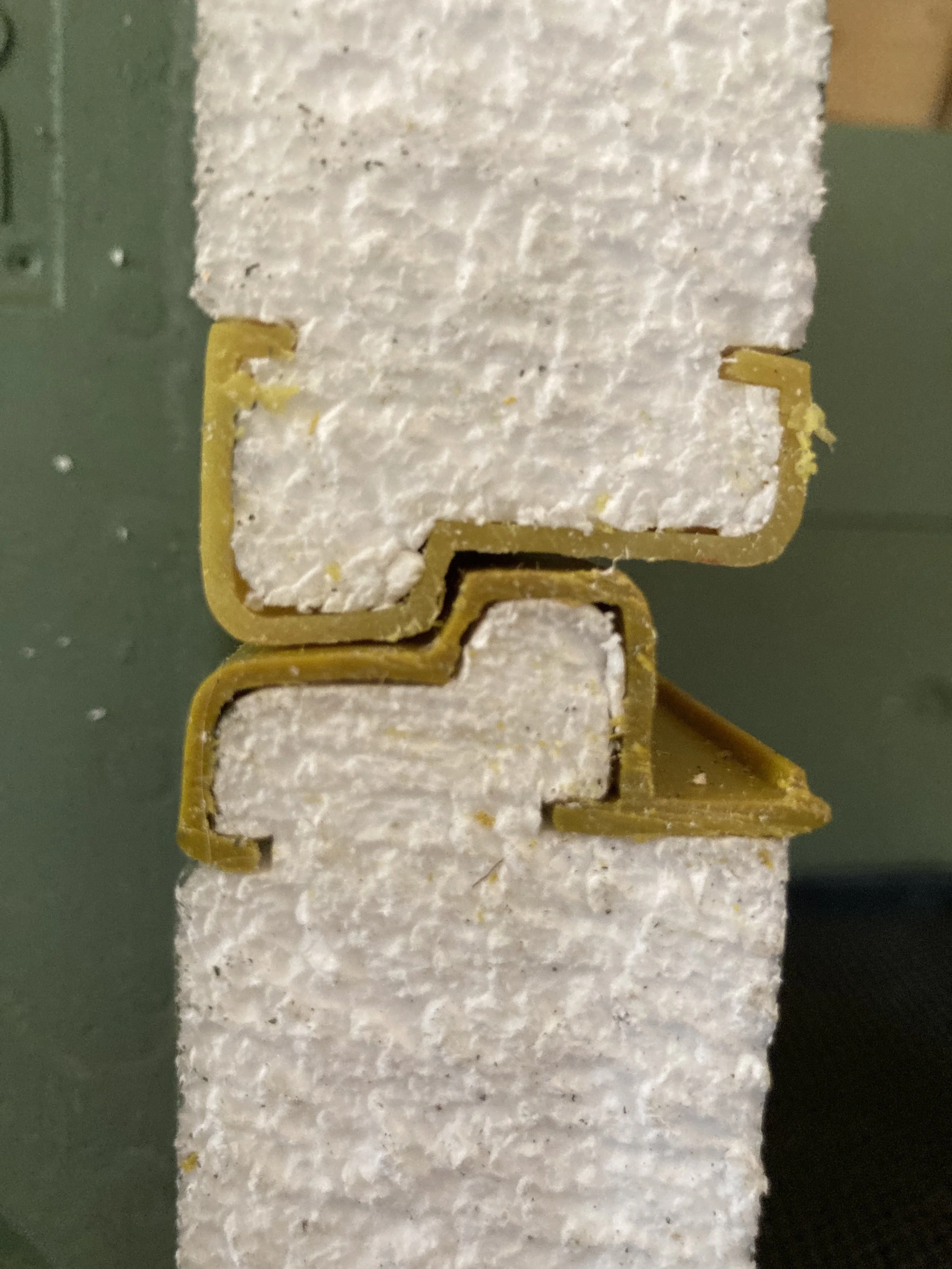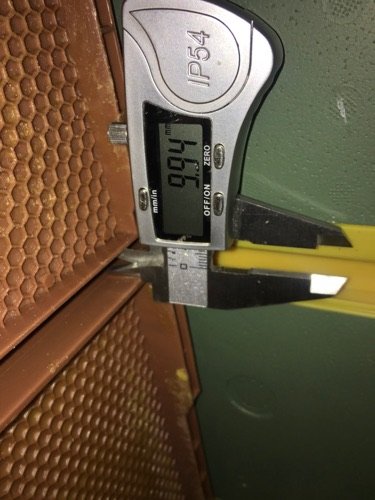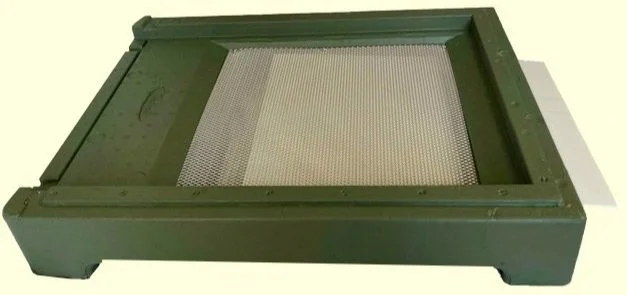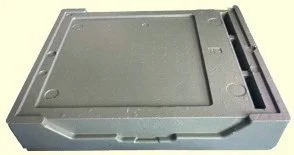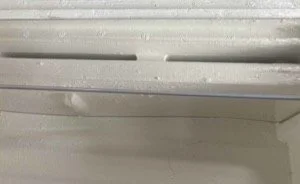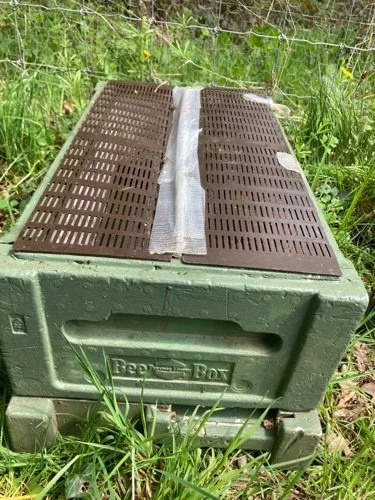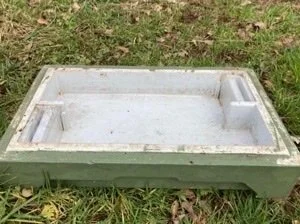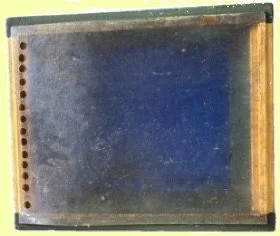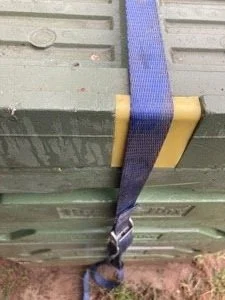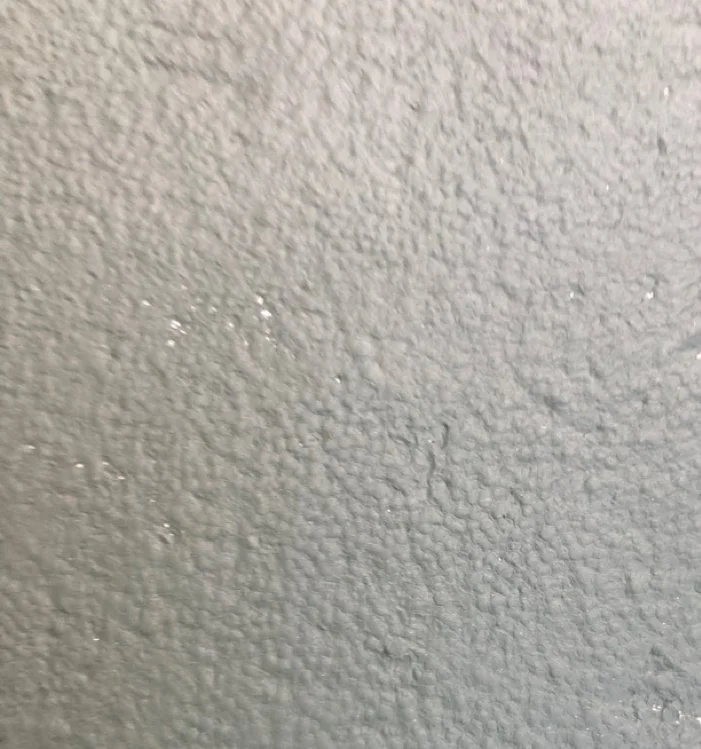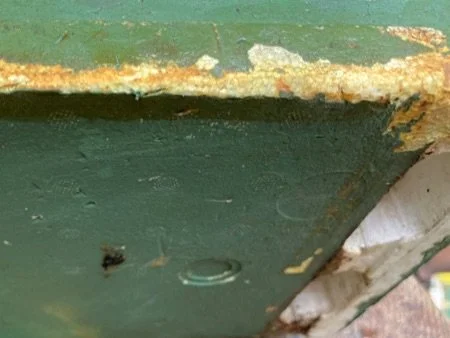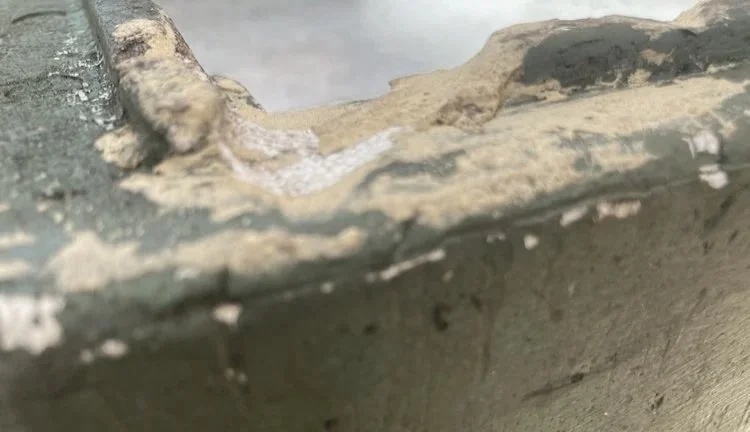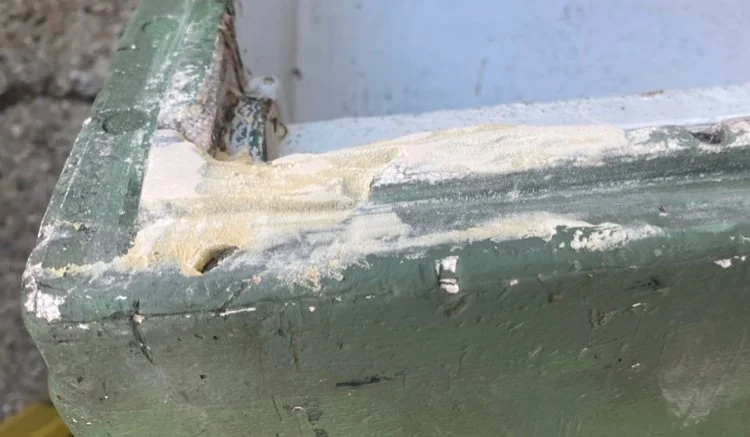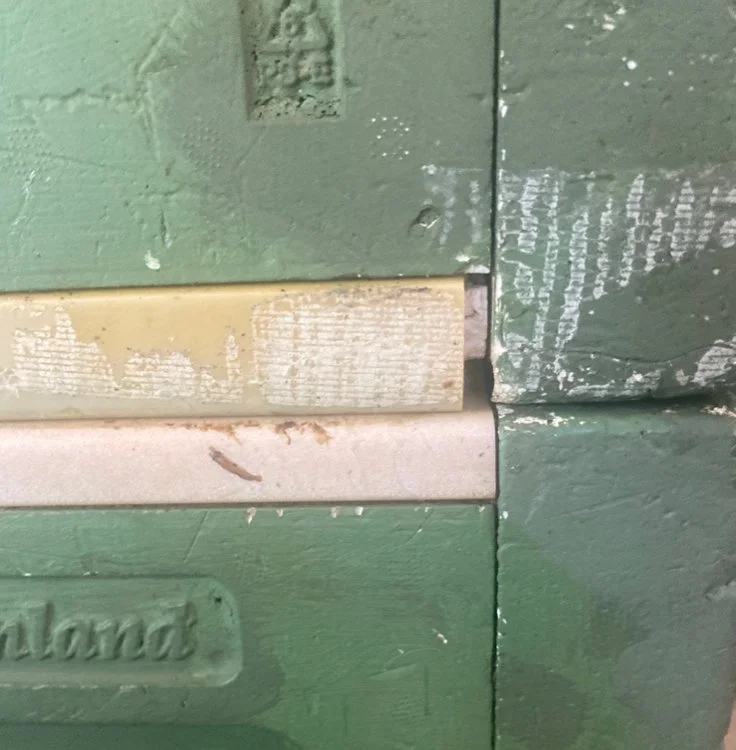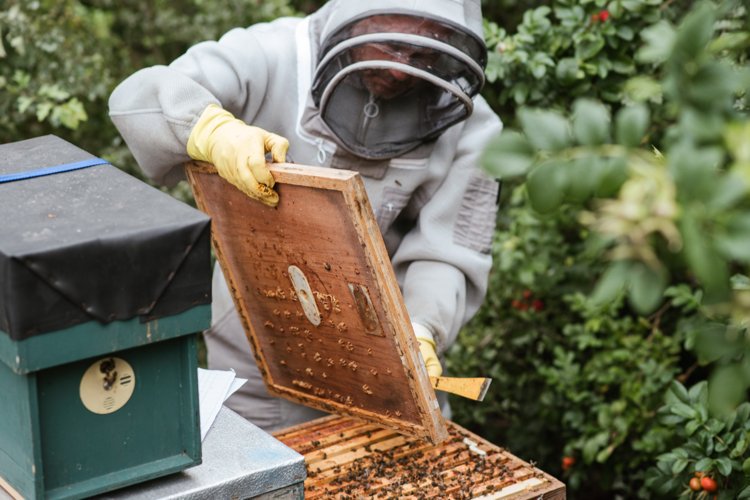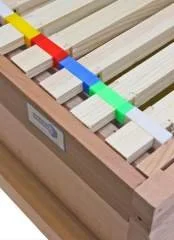
The Components of Paradise Honey Beehives
Dense polystyrene is a good insulator,
but easily damaged
A 25 min. read
Beebox manual Hive components Nucleus hive Retailer Temperature guidelines Insulation value
Paradise Beebox Beehives’ basic design is representative of most poly hives. They are sometimes called Modern Beekeeping hives (named after the original retailer). Some people shorten their name to Paradise Honey, Paradise or Beebox hives. British beekeepers use wooden hives, whereas many European beekeepers have endorsed plastic ones. The care and use of wooden hives is straightforward, and I explain this among the stuff about poly hives. If you are new to the world of beehives, read about the structure of a standard modern hive.
Note that wooden hives of a particular brand like National or Langstroth are standardised, apart from their roofs. They have an identical design, whereas each manufacturer of poly hives tries to produce a perfect hive with the best configuration. But none of them do. Each hive type has pros and cons, which I describe here. However, they are all insulated, which means that colonies build up rapidly in the spring, which increases the risk of early swarming, ramps up varroa levels and comes with the prospect of a larger honey crop.
Beebox special features
The Paradise hive bodies include generous handholds and hard plastic wall edges that protect the boxes when they are split open.
It provides the flexibility to have an upper entrance
The propolis screen can provide extra ventilation in hot weather or when moving hives long distances.
Castellations are available.
It is compatible with wooden hive bodies.
It comes with a simple queen/swarm trap device that can be used for swarm control without finding the queen or performing complex manipulations.
Unless the entrance reducer is modified, the hive boxes must be removed to replace or remove it. Careful adjustment removes this problem. Be careful, fumbling to get a modified entrance in place causes an exegesis of angry bees.
The entrance reducer makes it difficult for them to fan and must be removed at 20 degrees C. The reducer makes hive defence easy.
Paradise hives do not have a crown board, but one can work around that.
The runners are shallow, so there is a lack of space under the lugs; that’s not a issue with the correct technique.
The queen excluder is a precise fit. If the box above is heavy, it becomes impossible to keep the QE in position when the box is replaced. For these situations, I have reduced the excluder size or use a slotted metal excluder.
They are bottom beespace (not half top and half bottom space).
The Parts of a Beebox hive
The boxes/hive bodies
These are made of food grade hardened expanded polystyrene (EPS) at least 100 kg/m3 Once decorated with masonry paint (rather than gloss),they do not resemble the shiny plastic that may spring to mind. Paint the inside of the boxes to reduce the shedding of nano-plastics.However, recently, ghastly, pre-painted hives in shiny, bright colours have become available. I think they look like garden gnomes. All Abelo hives were initially painted like this, so I chose Paradise.
The Edges
If a runner is too short, wasps make an entrance
Lack of space under the lugs. Other hives have a deeper gutter, so bees can seek refuge there and are less likely to get hurt when a frame is moved. But frames in a Beebox can be wiggled into position to prevent this. It may make inspections marginally longer. Not significantly longer.
The yellow edges prevent damage when opening the hive and avoid water ingress. The external dimensions of a medium box are 17 × 45.7 × 84.2 cm. Using Langstroth mediums throughout the hive results in flexibility and simplicity.
The Corners and Runners
The upper view displays the runner/frame support (above the little hole in the picture)(the recess). The hole was the consequence of an experiment I conducted to ease the placement of the Queen excluder.
View from underneath
Hand-holds
Cross-section showing generous handholds.
Some people think that these depressions will significantly increase heat loss. Because a poly hive with 40 mm walls provides seven times greater insulation than 19 mm of wood. The depressed handle holds provides at least three times the insulation.
Queen excluder
Walls fit tightly together
QE (brown) Correctly positioned
QE incorrectly positioned
The Queen excluder (QE) is made of polypropylene, is quite floppy, and gets gently stuck to the frames but always remains easy to peel off. It works well, unless warped and the only times I’ve had a problem was when I placed it above the floor and the old-style entrance reducer flopped forward and created a queen-sized gap.
The QE fits the walls precisely – too precisely
It is a snug fit. This is good and ugly. It is easy to align a box with QE when the hive is light. If the QE gets warped as when heat cleaned, it won’t work.
When lifting a heavy box high, like running a two-queen hive, keeping the QE from being nudged out of position is a trial. The usual trick of placing the box in position by lining up one edge of the hive and then dropping it down like a door closing is not so easy. If fitting it is a problem, use the swarm trap or buy thin metal excluders that work a treat. A little trimming of the edges of the plastic QE makes things easier, but will make it fail when put above the floor.
Travel screen. With the same proportions as QE they can be used to harvest propolis or to increase ventilation.
The queen excluder is a tight fit that can be pushed out of position when replacing a box. A slotted metal excluder is a suitable alternative.
Swarm trap (ST)
The queen trap can be used as a second entrance, Bailey board, eke, hive floor and for swarm control.
Although inconsequential to its function, the bees put a load of propolis on the board's undersurface. I expect this could be relieved by making a shim/eke cut out of a single sheet of ply. The QE is replaced with wire mesh (OMF) when used as a floor.
Paradise Honey extols this device as a revolutionary innovation, and yes, it is handy that it is multifunctional. The trap can prevent and manage swarming and emergency queen cells, which is helpful if you are short of time and want to keep beekeeping simple. It works well.
Swarm trap instructions
Close the usual entrance.
Place the brood in one box under the ST. The bees have to enter the brood nest by going through the ST.
It traps drones and prevents the Q from leaving. Enough pollen gets through.
After 28 days, reverse the hive configuration and let the queen mate.
Check the colony two weeks later.
Explanation
There is no need to differentiate swarm from emergency cells. When the virgin queens emerge, they fight until only one or the old queen survives. If all the QC are unsealed at the start of the manipulation, wait 28 days. If there were sealed QC initially, I would leave the trap in position for a few days less, since the swarming urge lasts about three weeks. After this, the entrances are reversed, and a virgin queen can go out to mate.
This can be used as a regular method of swarm control and must be particularly useful for commercial beekeepers who do not have time to do splits. It is also helpful in poor weather when it is impossible to do a manipulation.
Very occasionally, perfect supersedure arises.
The trap does not resemble anything that bees do when they swarm. It feels unnatural. As with any swarm manipulation, rescue the old queen if she is valuable. So yes, it works, but unpleasant things happen. One of my colonies suffered the Inkpin Joe effect. This happened because I put the ST over two boxes. The lesson is only to use the trap with one. Another time, I found a queen crawling around with half her legs missing.
A big plus is that the bees in robust colonies continue foraging, although more sensitive ones seem dispirited and fly in and out with nothing to show. This is unsurprising as they are in a prolonged state of readiness to swarm, like someone bursting to pee. She won’t be laying any eggs.
If there is too much brood to fit in one box at the start, put the extra above the queen trap. Cut out all the QC, and repeat after six days.
If Queen cells arise, even if you think they could be supersedure cells (although I don’t recommend this), shut the usual hive entrance and open the board entrance. Job done. The Q is trapped beneath the excluder, and this stops her swarming. There is no need for complicated manipulations.
The Floor and Roof
Underside
It shows how the varroa board slides into position. The Open Mesh Floor (OMF) is 300 × 300 mm and covers half the area of the floor. The floor is recessed so dead bees collect there rather than block the entrance.
Side view
The mesh over the central hole — (OMF) is held in place by small screws
Front upper
Notice the groove that accommodates the entrance reducer. It is difficult to clean.
Rapid feeder
Top view
The feeder is made of dense polystyrene. Traditional advice is to paint the inside with three coats of gloss to prevent the sugar solution from leeching in. However, other poly hive manufacturers say it is unnecessary. I paint them to reduce the ingestion of nano-plastic, although I do not know the size of the risk. To feed fondant, the feeder can be inverted. Alternatively, remove the walkway cover and feed fondant in place of syrup.
Compare these with wooden feeders, which are bound to leak as the timber expands and contracts.
Under surface
The central area is sunken 6 mm to preserve beespace. However, at the walkway end, there is an area that is not recessed. This means it sits on top of the frames with no bee space and so necessitates scraping the wax off the frames and clearing the area of bees; Otherwise the feeder does not fit properly and bees get squashed. With the old feeder, there is no recess so you had to remove the wax from all the top bars and drive the bees down before replacing the feeder. Alternatively cover the frames with the plastic cover and draw it back slightly so the bees can reach the walkway.
Walkway
A perspex cover stops bees from drowning. The passage where they walk down to the syrup is best roughened using sand mixed with glue.
The feeder can be used to draw down stores; remove the perspex cover and block the walkway with strips of sponge except for a small access hole.
Roof
Feed plate cover
I don't know why a rectangular piece of correx sheet is available to cover the depression in the roof.
Under surface
The recess makes a perfect birdbath, a place to store notes, feed fondant, and for Apiguard.
Upper surface
The yellow plastic prevents damage from cam buckle belts.
Nucleus Hive
Nucleus hives are referred to as nucs, pronounced “nukes”. They are more akin to chromosomes than nuclear bombs. The appearance of BeeBox nucs grows on you. Holding six frames, they can be configured to make two, three frame nucs.
The nuc works well as a six-frame nuc and has an excellent rapid feeder. But, it requires some DIY to divide it in two.
Paradise nucs have entrances fore and aft, and the boxes can be stacked, creating 12 or 18-frame hives. The walls are about 33 mm thick, and the space under the frames measures 11 mm. The grooves on the sides and roof that fit the divider are shallow, so the bees do not fill them with propolis. The floor is removable.
The divider has fragile ends
Nucs house tender little colonies that need special care, particularly when overwintered. Hence, beekeepers with wooden hives often use poly nucs.
The divider for converting the nuc into two three-frames has a poor fit, and the customer is charged with cutting it to size (which is not easy). The mesh/screen/ OMF floor is prone to sag in the old models. Hence, as a precaution, it is wise to seal it with tape. Anotherr version of the nuc had a plastic OMF, which also failed to fit the divider. The most recent version has a bar under the partion - at last! Unfortunately, once more with Paradise, it seems to be a matter of two steps forward and one or two steps back; one new feature, a recession under the roof, is deeper than one beespace and only covers part of the surface. Also, the new roof is too small to form a good fit with the feeder. If all else fails, the nuc roof will be suitable for use as a bird table which will complement the full roof’s role as a bird bath.
Each side is best covered. I’ve used a propolis screen, but anything flat and stiff with straight edges would work fine. The covers ensure the colonies do not mingle. The edge braces the divider so that it fits the roof groove. It seems like Heath Robinson, but it only takes a few minutes to set up.
Nucleus Feeder
The feeder has feeding slots at both ends, so it is possible to feed two three-frame nucs.
Summary
Used for six frames, the nucs work well. The feeder is excellent, and the floor is removable. Using them as two three-frame nucs is underwhelming, and if they were better configured, I would overlook their ugliness.
Entrance Reducer (ER)
Over the past five years, the reducer has evolved from a flat piece of plastic with a lip to one with sliders. The most recent design has a 6.5 mm high entrance with 8 mm holes for drones at each end. Drones can squeeze through the standard part of the entrance. Perhaps the Finns have large drones. The picture shows the old-style reducer at the top and the most recent at the bottom.
The new styles fit securely, and the entrance is adjustable. In warm weather, they must be removed, so the bees can fan. They make it almost impossible to sublimate oxalic acid.
The sliders are a tight fit in the first two designs so that the runners need to be rubbed with fine sandpaper before use.
Some bees die in the winter. If many die, they may block the new-style entrances. I have never encountered this as the recessed floor works so well. Although it happened when I was observing the death of a nuc. With the old entrance, it is possible to scoop the dead bees out with a hive tool.
A disadvantage of the recent designs is that the bottom box must be removed before the entrance reducer can be inserted or removed. The middle-aged reducer can be adapted to overcome this by reducing the lip that fits under the box to precisely 5 mm, which means it clicks in and out.
All the reducers fit in a polystyrene slot situated in the floor. I prefer the old-style reducer, which looks primitive and has only two states: open or closed. However, I have cut a small notch in some so that the entrance can be reduced to one bee space. Only the old reducers can be reduced to 5.5 mm, as is required in the eventuality of Asian hornet attacks.
The entrance size with the old style is 370 x 6.5 mm which equates to 24 cm2; whilst the new ones are 160 x 6.5 mm which is 10.4 cm2. Considering feral bees in the USA prefer an entrance in the region of 10-20 cm2, the profiles of all the entrance reducers are reasonable.
The bottom box must be removed before the modern entrance reducer can be inserted or removed.
It is easy to make the old-style entrances out of Correx. I’ve made a couple from aluminium off-cuts. The sun makes them hot, so the bees beard when the entrance is reduced to one bee space.
The new entrance is not backwards compatible. The old floors have a recess at each end, and the new ones don’t. Fill the recesses with wood filler to use the new reducers with old floors.
When there is a gap behind the queen excluder, some bees prefer to use this rather than the yawning entrance.
Entrance feeder
This is not part of the Paradise hive. But it is handy. It just about fits the old-style entrance; it needs a little shelf to sit on.
These little feeders are great for providing water in hot weather.
Upper entrance
Paradise Honey recommends that the roof should be inverted if the temperature exceeds 30 degrees C. On this occasion, I’ve put a Swarm Trap at the top of the boxes with its mesh exposed. In this way, the entrance can be used for ventilation without creating a second entrance.
The roof can be inverted to form an upper entrance
Inner cover
This is a sheet of stiff transparent plastic. It prevents frames from sticking to the roof and can be used to control the aperture of the upper entrance. I have drilled some holes at one end, so the bees can access the feeder.
Cam buckle strap
Great for securing the roof. Otherwise, use a 2+ kg stone.
Damage from Chewing
Chewing is a problem with all poly hives. They chew the upper edges of boxes and the edges of cracks around the entrance and the internal walls (if you haven’t painted them). Awareness of this issue is vital. Fill cracks with wood filler as soon as possible. Four layers of varnish helps a little, but it is removed by hot washing. Duct tape protects the wall edges and (Gorilla tape) survives a hot wash. Hammerite paint only helps for one year. The inner cover protects the roof.
Chewed corner
Normal inner wall surface
Inner wall which was unpainted for 9 years
Chewed wall edge
A filled hole that has been opened
Filled hole
Wasp hole
Bees love chewing polystyrene; this could significantly reduce a hives’ working live.
Crown board
This is standard with wooden hives and with many poly hives. A poly hive crown board is a flat sheet of Extruded polystyrene (EPS) or plywood kept under the roof. Beeboxes do not have a crown board, which, on first consideration, seems shameful. Standard ones supplied with other hives have a hole for a clearer device called a Porter Bee Escape (to move the bees out of the supers at harvest time), but these are slow and prone to malfunction. Try not to use them.
Wooden boards are insufficiently deep to act as an eke, but can be used to draw down stores. Using a Beebox feeder with the entrance partially blocked works just as well.
Most wooden Langstroth clearer boards will fit Beeboxes and are available to buy. Making a board yourself is dead easy., Alternatively, hope for an Indian summer and use a DIY fume board.
The picture shows how the bees make burr comb despite a correct bee space. With Beeboxes, there is no trouble with stuck-down crown boards or stuck roofs, as the plastic inner cover peels off easily. Plastic frames rarely bridge the vertical space between the frames.
Beeboxes do not have a crown board. However, the Swarm Trap can be used as an eke, and the Rapid Feeder combined with some sponge can be used to draw down stores. The hive is compatible with an off-the-shelf Langstroth clearer boards.
Compatibility
Beebox hives are compatible with wooden hives.
This is demonstrated by Tony West. Generally, poly hives are bottom space, and wooden Nationals are, too.
But top-space Nationals such as the premier Abelo are available. Most manufacturers of wooden hives will make you top space boxes on request.
Image: bee-equipment.co.uk
Mixing bee-space — more detail:
Top bee-space on top of a bottom-space box obliterates the bee-space.
Bottom space above a top space-box. Creates a humungous bee-space.
In the first scenario, a workaround is to use a metal QE with a wooden frame with a bee space on both sides. Otherwise, you would need to use a very shallow eke.
Castellations: Modern Beekeeping
Spacers – as sold by Thorne
Castellations work by spreading Super frames further apart than usual. This advantageous feature makes it easier to slice the cappings off when processing honey; They result in more honey per frame. The same effect can be achieved with wooden frames by using plastic spacers on the lugs.
Smart Beebox hive
The Smart Hive has arrived. Its method of action looks less clunky than the Flow hive. Due to its insulation, bees will use the entire width of the boxes. It is only made in Langstroth Deep. £330 (2022). The innovative design allows honey that crystallises slowly to be harvested without opening the hive.
Summary
The hive build is sound and has a good feeder. The Swarm trap means you can manage queen cells with your eyes closed, but the entrance reducer is clunky. If you don’t know otherwise, the entrance reducer is okay. You could make an alternative out of Correx. Standard wooden frames don’t fit the boxes. You’ll need to grind down the ends of the lugs. A suitable bench grinder costs £25 (2024). The space under the roof provides an excellent place to keep hive records, apply Apiguard (if the colony is living on one hive body) or for a small amount of fondant. The inner cover must occlude the space under the roof to prevent brace comb.
If the roof is inverted, it can be used as a top entrance.
The feeder can be used to feed fondant or for them to draw down stores.
The National and Langstroth Beeboxes take ten frames. (wooden Nationals take 11 frames and Langstroth 8, 9 or 10. (Manley can be wider than Hoffman frames).
When making bits of kit like ekes, the lip on the walls makes construction more involved. However, temporary boards like clearer boards only need to fit the inner profile.
Paradise Honey has made gradual improvements over the past few years: floor, entrance, nuc, queen trap, and roof.
The plastic edges on the boxes protect the walls from damage when the boxes are cracked open. They also keep the boxes locked together when a hive is moved.
Some people say reduce colonies to one brood box as part of spring management. Colonies in BeeBoxes expand so rapidly that the colony needs two boxes. My experience is that unless preventative measures are taken, their strength in the spring leads to early swarming.
As with most hives, they have an OMF. However, it only covers half the floor. Size doesn’t matter for a subjective test like varroa mite drop.
The boxes can be stored/carried/cleaned with the sides unassembled, which is convenient, but the boxes age rapidly and are more likely to be nibbled, and fall apart when they contain honey.
Excellent hand-holds, insulation and no dampness.
The boxes are strong enough, but structurally weak compared with those moulded as one.
One study reckoned that raised humidity levels in poly hives caused bees to sting balls suspended in front of hives. So don’t pretend to be a ball. Winter humidity levels are usually recorded as being lower than wooden hives.
Use cold water to clean plastic queen excluders. Other wise they warp. I say do better, and use metal excluders.
The Beebox retailer in England
Modern beekeeping (MB)
Modern Beekeeping is the UK retailer of Paradise Honey hives. It is a family business owned by Paul Beardmore, that specialises in selling BeeBoxes, and Honey Paw hives and related equipment. Recently, they’ve added Sweinty to their range. Paul keeps over a hundred colonies in his Happy Valley Honey business.
Over the past decade, I have bought equipment from MB with mixed experiences, particularly in respect to their special offers.
Bee Equipment and British Bee Feed have stocked Paradise hives in the past, but have no intention of doing so in the future. The reason is that Paradise Honey, the manufacturer in Finland, only accepts large orders.
Using the hive – temperature guidelines.
There are two versions of the hive manual. If you believe in plenty of ventilation, I recommend this version. Contrast it with the more detailed ParadiseHoney.net manual. I don’t suppose either is evidence-based, and I’ve not been adherent. However, high humidity levels can arise in poly hives, so maybe plenty of ventilation is a good idea.
The hive should be placed on pallets or stands and positioned in the shade.
Use the Varroa board until the temperature reaches 20 degrees C and the nighttime temperatures are warming. (It gets filthy).
When the weather reaches 20+ degrees C, and the colony is strong enough to cover the brood, remove the entrance block so the entrance height is 18 mm (it should help them to cure honey).
When the temperature reaches 28 degrees C. the roof should be inverted and the inner cover drawn back 100 mm.
When the temperature exceeds 32 degrees C, the inner cover should be replaced with the propolis/travel screen and the inverted roof.
When using the rapid feeder, draw back the inner cover so they can reach the tunnel leading to the feeding slot. (when there are plenty of wasps?).
Beeboxes, Insulation and R-value.
The R-value is a measure of insulation. Paradise has an R-value of 7.9 compared with a dry wooden hive 1.21. (Beesource.com). An inch of fibreglass insulation has an R-value of 3.14. So what does this mean?
The R-value for a material is derived experimentally. It enables one to calculate the amount of heat (energy = watts) that is conducted (flows) through a material. The temperature differential divided by the R-value and then multiplied by the exposed surface area of the barrier gives the total rate of heat flow through the barrier, as measured in watts. When expressed as a formula, it looks somewhat like this: Watts = (temperature difference/R-value) x (area), which is good enough to compare the properties of things.
Pretend the cluster nuzzles under the roof in a wooden hive covering an area of 0.3×0.3 =0.9m2 with an R-factor of 1.21 with a temperature difference of 20 degrees C. This indicates that bees will need to produce 14.87 watts to stay warm. Using the same process for a Beebox, the bees expend 2.27 watts. A colony in a wooden hives requires 6.5 times more energy than one in a Beebox hive. The figures may not be quite correct, but this ratio concurs with Derek Mitchel, He writes:
“This experimental research, using various hives and thermal models of trees, has found that the heat transfer rate is approximately four to seven times greater in the hives in common use, compared to a typical tree enclosure in winter configuration. This gives a ratio of colony mass to lumped enclosure thermal conductance (MCR) of less than 0.8 kgW−1 K for wooden hives and greater than 5 kgW−1 K for tree enclosures”.
Thus giving a ratio of 6.25.
It is not so simple! Warm bees need less fuel to stay alive, but tend to move around more than cold bees. The cluster dynamics are not so simple. Poly hives and wooden hives probably require similar stores for overwintering, Winter losses are markedly different. Here is a list of some studies regarding the effect of hive insulation.
Things you may find interesting:
Instructions for use video by Devonbeekeeper
Comparison of polystyrene and wooden hives
Environmental impact of poly hives
What people say about BeeBox hives
Some research findings
It is claimed that poly hives have a 25% better honey yield than wooden hives. This makes sense, but I cannot find much research supporting it.
In a study performed in Italy, composite hives (insulation sandwiched between wood) yielded 14% more than poly hives and 35% more than wooden hives. (However, research from abroad cannot be translated into what happens in the UK). It is shy of links so copy and paste: https://doi.org/10.1080/1828051X.2019.1604088
The effect of thermal conductivity on foraging is somewhat complicated but look at their analysis towards the end.
A study performed in 2019 comparing survival, honey crops, and swarming, between plastic and wooden hives. All were increased in poly hives. Swarming behaviour was increased three times. Mortality rates were high compared to the UK. See the research:
Page H1


